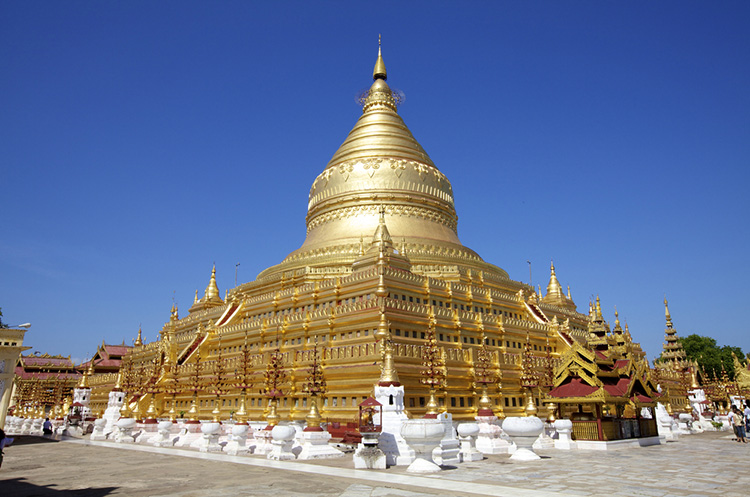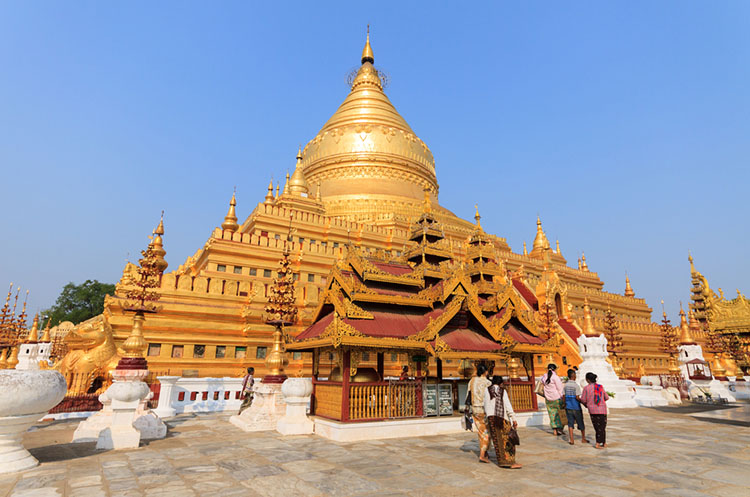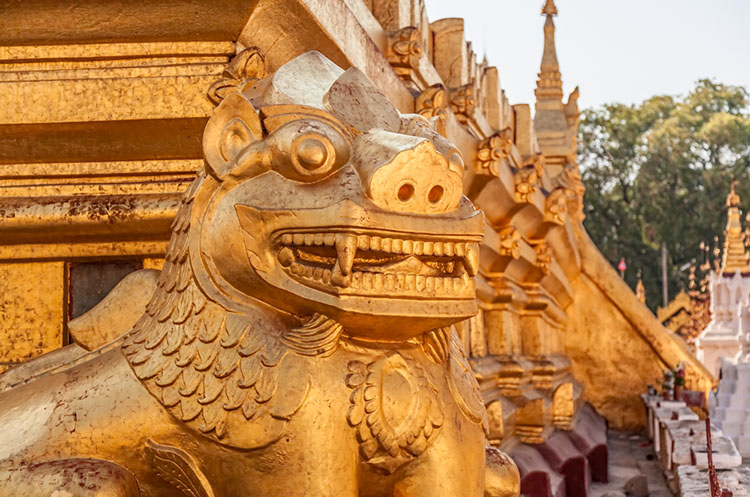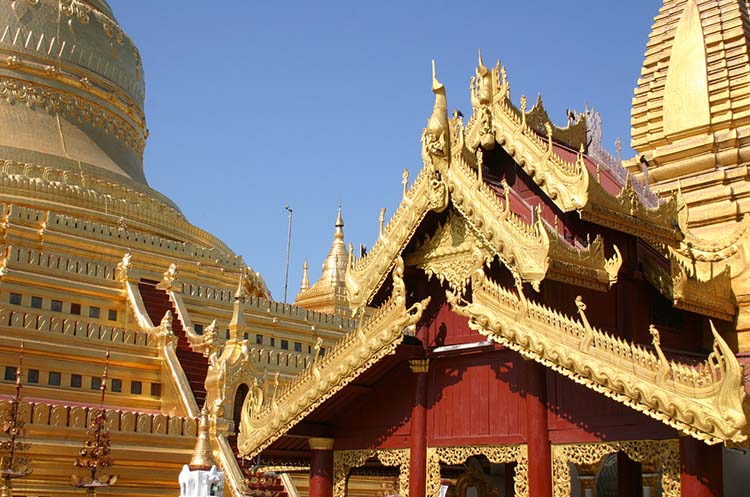
Shwezigon pagoda
Gold plated pagoda built by the founder of the Bagan empire
Single storey
The Shwezigon pagoda is one of the oldest and most impressive monuments of Bagan. Most noticeable is the huge gold plated pagoda glimmering in the sun. The design of the Shwezigon pagoda has been copied many times across Burma over the centuries.
After dark the pagoda is wonderfully illuminated by spotlights that give the place a mystical atmosphere. The Shwezigon was damaged by several earthquakes including the large 1975 quake, but has been restored since.
Pilgrimage site
Several shrines and temple buildings have been added to the complex since construction of the stupa in the year 1090. As the pagoda enshrines a number of sacred Buddhist relics, it is an important pilgrimage site for Buddhists.

Shwezigon festival
The Shwezigon festival held during the 9th month of the Burmese calender (December) attracts thousands of devotees. This was originally a month dedicated to paying respect to the ancient Nat spirits, before Theravada Buddhism became prevalent in Burma.
Start of massive temple building in Bagan
The Shwezigon pagoda was built by King Anawrahta who founded the Bagan Kingdom in 1044. After a monk from the Thaton Kingdom had converted the King to Theravada Buddhism the campaign of massive temple building began on the plains of Bagan.

Built to enshrine Buddha relics
King Anawrahta built the pagoda to enshrine several Buddha relics, including a copy of the sacred tooth relic of Kandy in Sri Lanka. According to legend, the spot where the pagoda was to be built was chosen by a white elephant carrying the relic on his back. Construction started around 1059, the pagoda was completed at the end of the 11th century during the reign of King Kyanzittha.
The gold plated pagoda
The pagoda sits in the center of a large platform, around which several other shrines and pagodas have been built. The bell shaped stupa that is completely gilded sits on a square base, of which the sides are about 49 meters long. At the base of the pagoda sits a large golden lion at each of its corners. On top of the base are three receding terraces. The third one has a small stupa on each of its four corners.
The solid and completely symmetrical stupa on top of the terraces is almost 49 meters high. On top of the pagoda is a hti, a spire ornament shaped as an umbrella, that is found on almost every Burmese temple.

Guarded by Makaras
All four sides of the pagoda have a central stairway guarded by Makaras (sea creatures from Hindu mythology) leading to the top of the terraces. The three terraces contain beautiful glazed terra-cotta plaques depicting scenes from the 547 Jataka tales, the stories about the previous lives of the Buddha.
Images of Nat spirits
Before Buddhism was introduced to Bagan, Nat spirit worshipping was prevalent. King Anawrahta allowed the images of the 37 most highly venerated Nats to be put on the lower terraces of the Shwezigon pagoda. The Nat images have since been moved and can now be found inside a small hall next to the platform.
Nat worshipping is still very much alive in current day Burma, the Mount Popa close to Bagan is known as the home of the Nats.
Large standing Buddha image
Along all four sides of the pagoda opposite the stairway to the third terrace is a pavilion that contains a large standing Buddha image from the 12th century. Two pillars with texts inscribed in Mon language from the end of the 11th century tell the early history of the Shwezigon pagoda.
Other structures on the Shwezigon complex
The Shwezigon complex is surrounded by a wall measuring 230 meters on each side with an access gate in all of its four sides. At the main entrance gate is an enormous white mythological lion standing guard. A long covered walkway with vendors leads to the pagoda.
During the centuries following the construction of the pagoda several other structures have been added to the temple complex. Around the platform are several Tazaungs, a Burmese style open pavilion. A number of temple buildings are topped with a Pyatthat, an intricately decorated Burmese roof made of several receding layers.
Several structures are topped with a shikhara, a tower like structure originating from North India. Unlike the shikhara of the Ananda temple that is one of Bagan’s best known landmarks, these shikharas are not gilded. The complex also contains a small whitewashed pagoda and several structures where Buddha images are enshrined.
Getting to the pagoda
Other temples in Bagan
Among the other temples & pagodas in Bagan are:
- Ananda pagoda
- Gawdawpalin temple
- Sulamani temple
- Thatbyinnyu temple
- Seinnyet sister temples
- Bupaya pagoda
- Mahabodhi temple
- Htilominlo temple
- Mingalazedi pagoda
- Dhammayazika pagoda
- Dhammayangyi temple
- Lawkananda pagoda
- Manuha temple
- Pyathadar temple
- Pahtothamya temple
- Myazedi pagoda
- Shwesandaw pagoda
- Gubyaukgyi temple
History
How to get to Bagan and how to get around
- Shwezigon pagoda
- Ananda pagoda
- Gawdawpalin temple
- Sulamani temple
- Thatbyinnyu temple
- Seinnyet sister temples
- Bupaya pagoda
- Mahabodhi temple
- Htilominlo temple
- Mingalazedi pagoda
- Dhammayazika pagoda
- Dhammayangyi temple
- Lawkananda pagoda
- Manuha temple
- Pyathadar temple
- Pahtothamya temple
- Myazedi pagoda
- Shwesandaw pagoda
- Gubyaukgyi temple